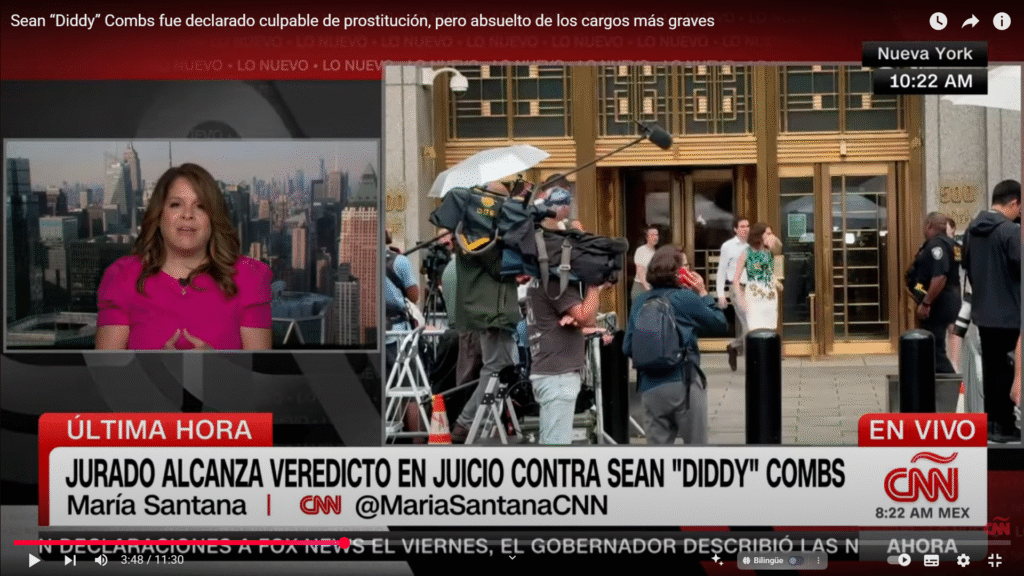Justice Speaks: The jury’s verdict in the controversial federal case against hip-hop icon Sean Diddy Combs
For weeks, the eyes of the public and the entertainment industry were focused on a New York courtroom. The federal trial against Sean Combs, known worldwide as Diddy, generated a stir due to the seriousness of the charges: from racketeering conspiracy to forced sex trafficking. Finally, the jury has returned its verdict, and although Diddy avoided the most serious charges, the shadow of controversy lingers.
The music producer, entrepreneur, and central figure in pop culture was found not guilty on the most serious charges, including criminal conspiracy and forced sex trafficking. However, the jury did find him guilty of transportation for the purpose of prostitution , which could mean up to 10 years in prison, depending on the judge’s upcoming sentence.
What was Sean Combs charged with?
The case against Combs included five federal charges, of which he was acquitted on four:
- Conspiracy to commit racketeering : the most serious charge, which could have resulted in a life sentence. He was found not guilty.
- Forced sex trafficking by fraud or coercion : carried a minimum sentence of 15 years. He was also acquitted.
- Two additional similar charges of sex trafficking : acquitted on both.
- Transportation for the purpose of engaging in prostitution : He was found guilty . This charge carries a maximum sentence of 10 years in prison.
The verdict comes after a 29-day trial in which the jury heard testimony from 34 witnesses, including Combs’ ex-partners, Cassie Ventura, and a woman identified as “Jane.”
What does a conviction for transportation for prostitution entail?
This charge alleges that Combs facilitated the transportation of people across state lines to engage in sexual activity in exchange for money. According to witnesses, the businessman hired men to have sex with their partners during private parties, often organized with drugs and psychological pressure.
Although the jury dismissed the allegations of coercion and systematic abuse, it did find credible that a facility was set up to transport people for the purpose of sexual exploitation, which constitutes a federal crime.
What legal consequences could Diddy face now?
Although the final judgment is in the hands of the judge, there are several scenarios:
- Maximum sentence of 10 years : if only one charge is considered and it runs concurrently.
- Sentence of up to 20 years : if the judge decides that the two transportation charges are to be served consecutively (one after the other).
- Minimum sentence of 7 years : Because, in the case of federal charges, the law requires serving at least 75% of the sentence.
Combs is currently being held at the Metropolitan Correction Center in Brooklyn, where he has been since his arrest.
4 key takeaways from the Sean Diddy Combs trial
- The Burden of Evidence in Conspiracy Cases
Despite explicit testimony and serious accusations, the jury found there was insufficient evidence to confirm the existence of an organized criminal network. - The difference between consent and coercion.
The defense argued that the sexual activities were between adults and consensual. Although abuse was alleged, the jury found no compelling evidence of coercion. - The damage to his public image is irreversible.
Despite being acquitted on the most serious charges, Combs’ reputation has been severely damaged. His image as a respected businessman and musical mentor has been tarnished by the revelations. - Comparisons to Cases Like Jeffrey Epstein’s
Some media outlets and observers have compared Combs’ case to that of tycoon Epstein, due to the nature of the private parties, drug use, and the alleged involvement of other celebrities. However, to date, no other names have been officially linked in court.
What can we learn from this media case?
Beyond the morbid curiosity surrounding public figures involved in judicial scandals, Diddy’s case raises important questions about the functioning of the justice system and the impact of fame:
- Justice requires solid evidence, not just poignant testimony.
Although many witnesses described disturbing acts, it wasn’t enough for the jury to convict on the most serious charges. - Social and media pressure doesn’t determine a verdict.
This case received international attention, but the jury deliberated based on evidence, not public opinion. - Society’s judgment doesn’t always wait for justice.
Despite the ruling, Combs’s image has suffered damage that is difficult to repair. Major brands and allies could distance themselves completely.
What’s next for Sean Combs?
The next step will be the sentencing hearing, where the judge will decide how many years Diddy will serve in prison. This stage is crucial, as it will influence not only his personal life but also his legacy as a public figure.
At 55, a sentence of 10 years—or even more—would mean Combs would spend much of the rest of his productive life behind bars. And while his legal team could appeal the ruling, the conviction has already dealt a devastating blow to his artistic and business career.
The verdict marks a turning point in the career of the producer and entrepreneur who revolutionized hip-hop in the 1990s. While some celebrate his partial acquittal, others lament that full justice has not been served in the most serious cases of abuse. In any case, Sean Diddy Combs’ story will serve as an example of how even the most influential icons can face legal consequences when testimony, evidence, and the judicial system all align.
Stay informed and follow this case closely. The official ruling is coming soon, and it could change everything.



